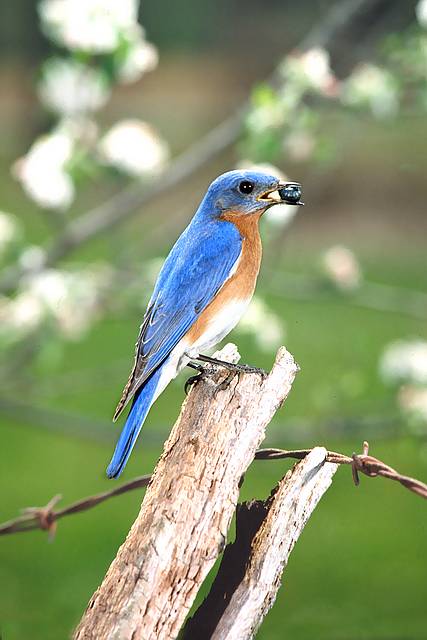-
Live Meal Worms for Better Birding!
Squeamish about worms in the past, I’ve learned to like them! After trying and trying to attract bluebirds, it was the live meal worms that did the trick. Once I started feeding them, the bluebirds were seen everyday. They even decided to take up residence and nest in one of the bluebird houses. Not one, but two successful broods came into being last spring. I was so darn proud!
Now, in the dead of winter, with snow in Atlanta, my bluebirds have remained. Three heated birdbaths provide fresh, warm drinking water, and the worms come out every day. I think they’re pretty happy to brave the elements.
Feeding live meal worms attracts the most sought-after birds, it’s a sure way to attract song birds and exceptionally brilliant birds like tanagers, robins, orioles, cardinals and goldfinches. After tring everything, I think it is the only way to attract the elusive bluebird!
The benefits of feeding live meal worms include:
•Draw a far wider range of bird species in the garden
•Provide a high-quality source of protein and fat
•Adds a new dimension to bird feeding
•Witness new behaviors from regular visitors
•Get wild birds to feed from your hand! -
Ducks and Meal Worms?
While walking the dog at a local park last week I decided to feed the ducks as the weather was blustery cold. I know they’re sick of bread because that’s what everyone feeds them. Some cracked corn borrowed from the squirrels would work, but it seemed they need a little something with more substance. Suet? nah…might not be so good for them. I decided to borrow from the bluebird stash and grabbed some meal worms. The ducks loved them! It might be their favorite as I don’t believe any other duck feeder uses them at this park.
Meal worms were the trick that got bluebirds nesting in my yard last spring. With two successful broods I realized I was going to be buying worms as a staple now. The heated baths is what keeps them during freezing winter temperatures.
Easy to keep – the meal worms live in a container in the fridge with some wheat bran for bedding. What I failed to realize is your supposed to feed the worms too! With a horse, a dog, and five cats I’m thinking: feed the meal worms??????
-
The Great Backyard Bird Count Info
Project FeederWatch Electronic Newsletter
February 8, 2010
If you are counting for Project FeederWatch from February 12 through 15, your counts can do double duty if you enter the same tallies into the web site for the 13th annual Great Backyard Bird Count (GBBC). It’s a step well worth taking to make sure the GBBC database includes your information and collects as many observations as possible. After you enter your checklists on the GBBC website, take a few moments to explore reports coming in from across the continent and upload images for the photo contest. Tweet about the birds you’re seeing and by including the #gbbc hashtag, your comments will appear in the Twitter widget on the GBBC home page. Just by participating in the GBBC you’ll be entered into a drawing for great prizes. The GBBC is a joint project of the Cornell Lab of Ornithology and the National Audubon Society with new Canadian partner, Bird Studies Canada and sponsorship from Wild Birds Unlimited The rules for counting for the GBBC are a little different than for FeederWatch. For the GBBC you can report any birds you see at your wild bird feeders, even those birds flying overhead that don’t count for FeederWatch. You can also submit a separate checklist for each locale on every day that you count. Join the Great Backyard Bird Count this year and Count for Fun, Count for the Future!
Evening Grosbeak by Ted Schroeder, 2009 GBBC.
* * * * * * Project FeederWatch Contact Information
For US participants:
Cornell Lab of Ornithology
Project FeederWatch
159 Sapsucker Woods Rd., Ithaca, NY 14850
(607) 254-2427
[email protected]
http://birds.cornell.edu/pfwFor Canadian participants:
Bird Studies Canada/Etudes d’Oiseaux Canada P.O. Box 160 Port Rowan, ON N0E 1M0
(519) 586-3531
[email protected]
Toll Free: 1-888-448-BIRD (2473)
http://www.bsc-eoc.org/national/pfw.htmlProject FeederWatch is a joint project of the Cornell Lab of Ornithology and Bird Studies Canada.
The Cornell Lab of Ornithology is a nonprofit organization supported by friends and members. Our mission is to interpret and conserve the earth’s biological diversity through research, education, and citizen science focused on birds. Watch our video about how you can join us as a “force for nature!”


